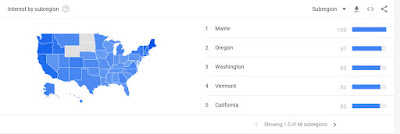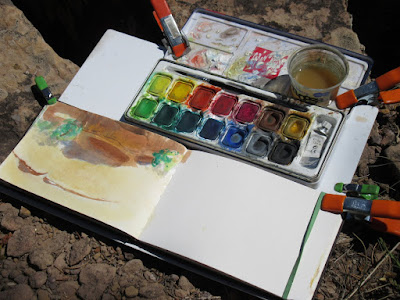 |
| Canyon Wall, 5x8 gouache One of my latest sketches from my "Pandemic Sketchbooks, Vol.2" |
Gouache—what the French called the medium starting in the 18th century—is trending right now in the US. Everyone seems to be experimenting with it.
In the graphic below, from Google Trends, you can see a big uptick in searching for the word “gouache” in May of this year. Although the curve has dipped a bit since then, it's still higher than before. It's also interesting to look at the map that shows which states search most often for the term. The west coast and New England seem particularly interested in finding out more about this opaque water medium.
 |
| Number of Searches for "Gouache" since 2018 |
 |
| States with the Most Searches for "Gouache" |
I first learned about gouache a long time ago while reading up on the history of illustration. I learned much more about it by following the artist James Gurney in his blog. Then I started playing with it myself a couple of years ago, when I wanted something more travel-ready than oil or pastels. My good friend Douglas Runyan steered me to my current kit. Now, as I check my Instagram feed and browse through the art instruction magazines, paintings in gouache or articles about gouache pop up regularly.
Gouache is basically opaque watercolor. What gives it its distinctive opacity is the size of the pigment particles, which are larger than that used for watercolor. Also, sometimes chalk is added to increase the opacity.
But why use gouache instead of watercolor? Isn't watercolor just as travel-ready? Well, the benefit of gouache lies in its opacity. It lets the painter scumble one color over another for a beautiful “broken color” effect. Also, it's easy to correct mistakes. Nor does one have to worry about “saving the lights” when painting areas with bright highlights.
Gouache also dries to a matte finish, which is perfect for photography, since you don't have to worry about reflections. This is why it was—and continues to be—used for illustration and commercial work.
 |
| A Concept Sketch for an Advertisement in Gouache |
But there's one problem with gouache, and that is that the darks dry a little light, losing some of their depth. I often have to revisit the field sketch once I'm back in the studio and hit those darks again.
The Egyptians used gouache. They combined ground pigment with honey or gum tragacanth—two binders also used in watercolor—to make a paste for decorating walls. During the Middle Ages, it was used in manuscript illumination. In the 20th century, before the advent of digital art, it was used in commercial art because it was “quick'n'dirty”—much faster than painting in oil if you just wanted to do a concept sketch. Plus, as I mentioned, it photographed well. The only problem with “designer's gouache” or “body color” as it was called then, was that not all of the colors were lightfast. That has changed today, and most gouache manufacturers use lightfast pigments.
I'm continuing my practice of using it for my daily sketches. I have a bag, ready to go, with everything I need in it, including a sheet of eggcrate foam to cushion my backside when sitting on a rock. For me, painting in gouache is stress-free—just the prescription for today's times.
You can see more of my gouache sketches on my Instagram feed.
 |
| My Gouache Kit (You can read more about it here) |
